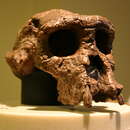Brief Summary
provided by EOL authors
Where Lived: Western Africa (Chad) When Lived: Sometime between 7 and 6 million years ago Sahelanthropus tchadensis is one of the oldest known species on the human family tree. This species lived sometime between 7 and 6 million years ago in West-Central Africa (Chad). Walking upright may have helped this species survive in the diverse habitats—including forests and grasslands Though we only have cranial material from Sahelanthropus, studies so far indicates this early human had a combination of apelike and humanlike features. Their apelike features included a small brain (even slightly smaller than a chimpanzee’s!) sloping face, very prominent brow ridges, and elongated skull. Their humanlike features included small canine teeth, a short middle part of the face, and a spinal cord opening beneath the skull instead of towards the back, like in nonbipedal primates (or apes). How do we know Sahelanthropus walked upright? Some of the oldest evidence for walking on two legs comes from Sahelanthropus. The large opening (foramen magnum) in the base of the cranium where the spinal cord connects with the brain is positioned further forward (the underside of the cranium) than in apes or any other primate except humans. This feature indicates that the head of Sahelanthropus was held on an upright body.
- license
- cc-by-nc
- copyright
- Human Origins Program
Size
provided by EOL authors
Because scientists have only recovered a single skull and some jaw and tooth fragments belonging to Sahelanthropus (no post-cranial fossils), we don’t know yet exactly how big an individual of this species would have been. Given the size of TM 266-01-060-1 skull, scientists estimate that Sahelanthropus individuals would probably be similar in size to a chimpanzee.
- license
- cc-by-nc
- copyright
- Human Origins Program
Evolutionary Tree Information
provided by EOL authors
The first early humans, or hominins, diverged from apes sometime between 6 and 7 million years ago in Africa. Sahelanthropus tchadensis has two defining human anatomical traits; 1) small canine teeth, and 2) walking upright on two legs instead of on four legs.
- license
- cc-by-nc
- copyright
- Human Origins Program
History of Discovery
provided by EOL authors
Year of Discovery: 2001 The first (and, so far, only) fossils of Sahelanthropus are nine cranial specimens from northern Chad. A research team of scientists led by French paleontologist Michael Brunet uncovered the fossils in 2001, including the type specimen TM 266-01-0606-1. Before 2001, early humans in Africa had only been found in the great rift valley in East Africa and sites in South Africa, so the discovery of Sahelanthropus fossils in West-Central Africa shows that the earliest humans were more widely distributed than previously thought.
- license
- cc-by-nc
- copyright
- Human Origins Program
How They Survived
provided by EOL authors
Unfortunately, most of Sahelanthropus’ teeth are heavily worn, and there have not yet been studies of its tooth wear or tooth isotopes to indicate diet. However, we can infer based on its environment and other early human species that it ate a mainly plant-based diet. This probably included leaves, fruit, seeds, roots, nuts, and insects.
- license
- cc-by-nc
- copyright
- Human Origins Program
Key Fossils
provided by EOL authors
TM 266-01-060-1 Nickname: Toumai Site: Toros-Menalla, Chad Date of discovery: 2001 Discovered by: A team led by Michel Brunet Age: Between 7 and 6 million years old Species: Sahelanthropus tchadensis One of the first human traits, the small canine teeth in this male skull distinguished it from other apes. Most male primates have long canine teeth that they use to threaten and harm other males. There may have been less competition among Sahelanthropus tchadensis males, or perhaps males expressed aggression in other ways. This skull, nearly complete though flattened by distortion, is also known by its nickname, ‘Toumai,’ which means ‘hope of life’ in the local Dazaga language of Chad.
- license
- cc-by-nc
- copyright
- Human Origins Program
The Unknown
provided by EOL authors
We don’t know everything about our early ancestors—but we keep learning more! Paleoanthropologists are constantly in the field, excavating new areas with groundbreaking technology, and continually filling in some of the gaps about our understanding of human evolution. Below are some of the still unanswered questions about Sahelanthropus tchadensis that may be answered with future discoveries: 1. What did the body of Sahelanthropus tchadensis look like? So far paleoanthropologists have only uncovered cranial fossils of this species. 2. What was their primary form of locomotion? 3. What did they eat? 4. Why did Sahelanthropus tchadensis males have smaller canines? This is unlike male chimpanzees and most other primates who use their long canine teeth to threaten others, especially when competing for mates. 5. Were there size differences between Sahelanthropus tchadensis males and females? 6. Was Sahelanthropus tchadensis a common ancestor of humans and chimpanzees?
- license
- cc-by-nc
- copyright
- Human Origins Program

